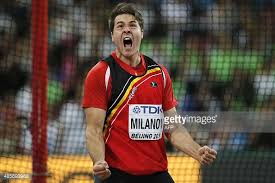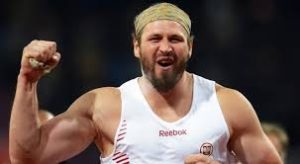Trofimuk and I disagree on this one, but twenty years of marriage has trained me to avoid conflict by employing subterfuge, and since I have the password to the blog and he doesn’t…here’s what I think.
This is going to be a two-man battle for the gold, with the bronze medal totally up for grabs.
The Contenders (for the bronze)
Mason Finley of the United States created great expectations for himself at a very young age by one, being ginormous, and two, breaking the all-time high school record in the disc. Seven up and down years later, he came up yuuuuge at this year’s Trials, hitting a PR 66.72m in the prelims and following that up with 63.42m for the win in the rain-soaked final. Trofimuk and I became fans of Mason when we interviewed him in Des Moines at the 2012 NCAA meet. At the time he was getting a lot of career advice from courageous internet trolls who were outraged that he was taking too long to develop into the next great American thrower, so we were afraid he might be a little surly with us media types. But he could not have been more gracious. He kind of fell off the map after graduating from the University of Wyoming in 2014, and we had no idea what he was up to until last summer when Mac Wilkins told us that Mason had spent a few months at the Chula Vista training center and had shown a lot of potential while there. He picked a great time, this Olympic year, to start realizing that potential and even though he is unlikely to get near the podium in Rio, if he can make the final and then stay in the game for another four years he may fulfill those expectations after all.
Daniel Stahl of Sweden finished fifth in Beijing last year. Twenty-five-years old, athletic and having just hit a PR of 66.92m last month, he is definitely a threat to medal in Rio.
Can it be eleven years since Estonia’s Gerd Kanter announced himself as the next great discus thrower by blasting a 68.57m toss at the 2005 World Championships in Helsinki? Virgilius Alekna came up big on his last throw to prevent Kanter from claiming the gold that night, but for Kanter, Helsinki was the beginning of a streak of dominance that included winning the Beijing Olympics and breaking the 70-meter mark in six consecutive seasons. The emergence of a certain German as maybe the best big-meet thrower in history (more on that below) pushed Gerd out of the limelight, but he remains a fierce competitor who rises to the occasion. Don’t forget, he came within a few centimeters of defeating that…uh…German fellow in London. Kanter’s best this season is the 65.27m he threw to take bronze at the European Championships. That won’t be enough to get him a medal in Rio, but don’t be surprised if this cagey veteran nails a season’s best and gets himself into the hunt.
Younger, taller, and mellower than his famous brother, Christoph Harting of Germany has flashed signs that he might be ready to succeed big bro as the best discus thrower in the world. 2015 was a breakthrough season for Chris, as he upped his PR nearly three meters to 67.93m and came within a phantom foul of medaling in Beijing. This year he threw 68.06m early and has been consistently in the 65-meter range since, taking fourth at the Euros with 65.13m. It can’t be easy operating in the shadow cast by big brother, and you hate to place too much importance on a single competition, but medaling in Rio would be a giant step in this young man’s career.
Philip Milanov of Belgium threw 66 meters in June of 2014, then must have gotten either injured or kidnapped because I was at the European Championships that August and do not recall seeing him throw. So, I was surprised as anyone last year when he broke the Belgian record with a 66.90m toss that got him the silver in Beijing. He hit a PR 67.26m this May, and finished second at the Euros with a 65.71m toss. If anyone could challenge the two Big Dogs (more on them in a moment) should they falter, it would likely be Milanov.
Robert Urbanek of Poland announced himself as a world class thrower with a 66.93m toss in 2012, and helped Poland to a 1-3 finish in the disc last year in Beijing by tossing 65.18m to take the bronze. He struggled at the Euros last month, finishing ninth at 62.18m. His best this year is 65.56m., and in spite of his struggles in Amsterdam, I see him as a twenty-nine-year-old version of Kanter in that he can be relied on to throw 65-something under pressure in a stadium. However, if things get nutty in Rio and it takes 68.00m to medal he will likely be out of luck.
The Contenders (for the Gold)
Piotr Malachowski of Poland is like those fantastic NBA teams of the 1990’s (Karl Malone’s Utah Jazz, Shawn Kemp’s Seattle Supersonics, Patrick Ewing’s New York Knicks, Hakeem Olajuwon’s Houston Rockets) who had no shot at winning a title as long as Michael Jordan was at his ass-kicking best. Piotr’s 67.82m silver-medal-winning toss at the Beijing Olympics should have set him up as the heir apparent to Kanter, and a 69.15m national record throw at the 2009 Worlds in Berlin seemed, for a few minutes anyway, to indicate that he was ready to assume the throne. But we all know how that turned out. (Buy me an iced tea and I’ll be glad to re-enact the BBC coverage of round six for you). Piotr had nobody but himself to blame for a lousy 9th place finish in Daegu, but he came back strong in London (67.19m) only to finish fifth, and even stronger in Moscow (68.36m) only to finish second to “He Who Shall Not Be Named Until the Next Paragraph.” Back to the basketball analogy, it wasn’t until Michael Jordan briefly retired that another team (Olajuwon’s Rockets) was able to win an NBA title. In Malachowski’s case, he finally broke through and became World Champion last year (with a 67.40m toss) when that Certain Someone was unable to compete in Beijing due to a knee injury. This year, Malachowski leads the world at 68.15m, is dominating the Diamond League race, and seems primed to make a run at his first Olympic gold. However…
…Robert Harting of Germany, the Dark Prince of the Discus, the Beast from the former East is back, and the beast…is…hungry.
I know this from personal experience. In March of 2015, four months his surgery for a torn ACL, I attended one of Harting’s practices. At the time, he was determined to get the knee ready for a defense of his World title that August in Beijing. I had interviewed him a year earlier and he had seemed like a pretty friendly guy, so of course I said hello as I approached the discus cage. He turned around, shirtless and looking mighty buff, and literally growled at me. A sane person probably would have dropped his notebook and made a run for it, and don’t think I didn’t consider it, but instead I just wet myself a little and then stuck around to watch as he treated every stand throw, every full, every imitation like it was round six of the Olympic final. His intensity was so intimidating that I climbed to the other side of a small fence that surrounded the throwing area just to signal that I was staying the heck out of his work space.
In hindsight, I think that accounts for the difference in his demeanor between the first couple times I met him and this particular moment. He didn’t mind having a semi-annoying American asking him a bunch of questions in a hotel lobby or as he relaxed at the track after a competition. But when it was time to work on his craft…well, that was a very different story.
As noted above, he was not able to make it back for the 2015 World Championships, and there were a couple of moments this spring when a torn pec and more trouble with the repaired knee threatened to derail his career for good. Then came the final round of the German Championships. The winner would receive a guaranteed spot in the Olympics. Everyone else would have to continue battling another three weeks for the remaining two slots. Robert wanted to secure that automatic bid so he could begin to focus strictly on Olympic prep, but as he stepped in for his final effort his brother sat in first place at 66.41m. I doubt anyone in that stadium was surprised by what happened next. Certainly Malachowski wouldn’t have been. A 68.04m bomb. Robert’s best throw in two years. The automatic bid secured. Order restored.
And the medals go to…
Trofimuk is a big guy, and it would hurt to be punched by him, so I am going to go ahead and give his predictions even though they are completely wrong.
Bronze: Robert Harting
Silver: Milanov
Gold: Malachowski
I…ahem…beg to differ.
Bronze: Chris Harting. He was also at that March 2015 practice and was super nice. Didn’t growl at me even once. For that, I am forever grateful.
Silver: Malachowski. I met Malachowski at the New York Diamond League meeting a couple of years ago. He is a really nice guy, and after we chatted for a while I thanked him for his time and told him I thought he was a great thrower. “Maybe,” he replied, “but Harting always beats me.” Unfortunately for Piotr, that trend will continue in Rio.
Gold: Robert Harting.



























































